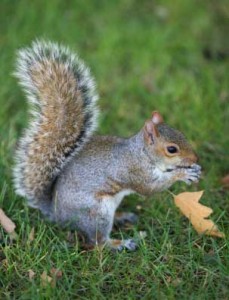A common autumnal sight is a squirrel, busily scurrying to bury his winter food supply of nuts. Have you ever thought about how much these furry little beasts have in common with woodworkers?
For one, both share a fine appreciation for oak.

Squirrels, however, may be even more discerning than woodworkers in distinguishing between the red oak and the white oak of this species. You may recall that forester Tim Knight, in his post on this blog entitled Red Oak White Oak: Telling the Difference, mentioned the different sprouting times of red and white oak acorns. What Tim didn’t mention is the “squirrel factor.”
Apparently, since white oak acorns’ natural tendency is to begin sprouting as soon as they’re in the ground, squirrels must take steps to guard against their food supply turning into trees: they bite through the seed cap to prevent sprouting.
For red oak acorns, since the germination period is longer, the squirrels don’t bother. (The apparent squirrel-brain theory is that they’re going to dig up all those acorns and eat them this winter, before they’d begin to sprout, so it’s not necessary. Now, you know and I know that they never find all of their stashes before spring, but let’s not disillusion the furry little guys, OK?)
How can they tell the difference? By the smell.
That made sense to me, since woodworker George Wurtzel, an instructor at the Minneapolis Blind, Inc. Blindness Training Center, had mentioned this summer that he and his students can also tell red and white oak apart by the sniff test. (The article on George’s program is in the August 2011 Woodworker’s Journal; a video is here.)
But it was neither George nor Tim who told me about the squirrels’ expertise: that, I discovered while reading National Geographic Little Kids First Big Book of Why.
Woodworking, like fall leaves, is everywhere.





